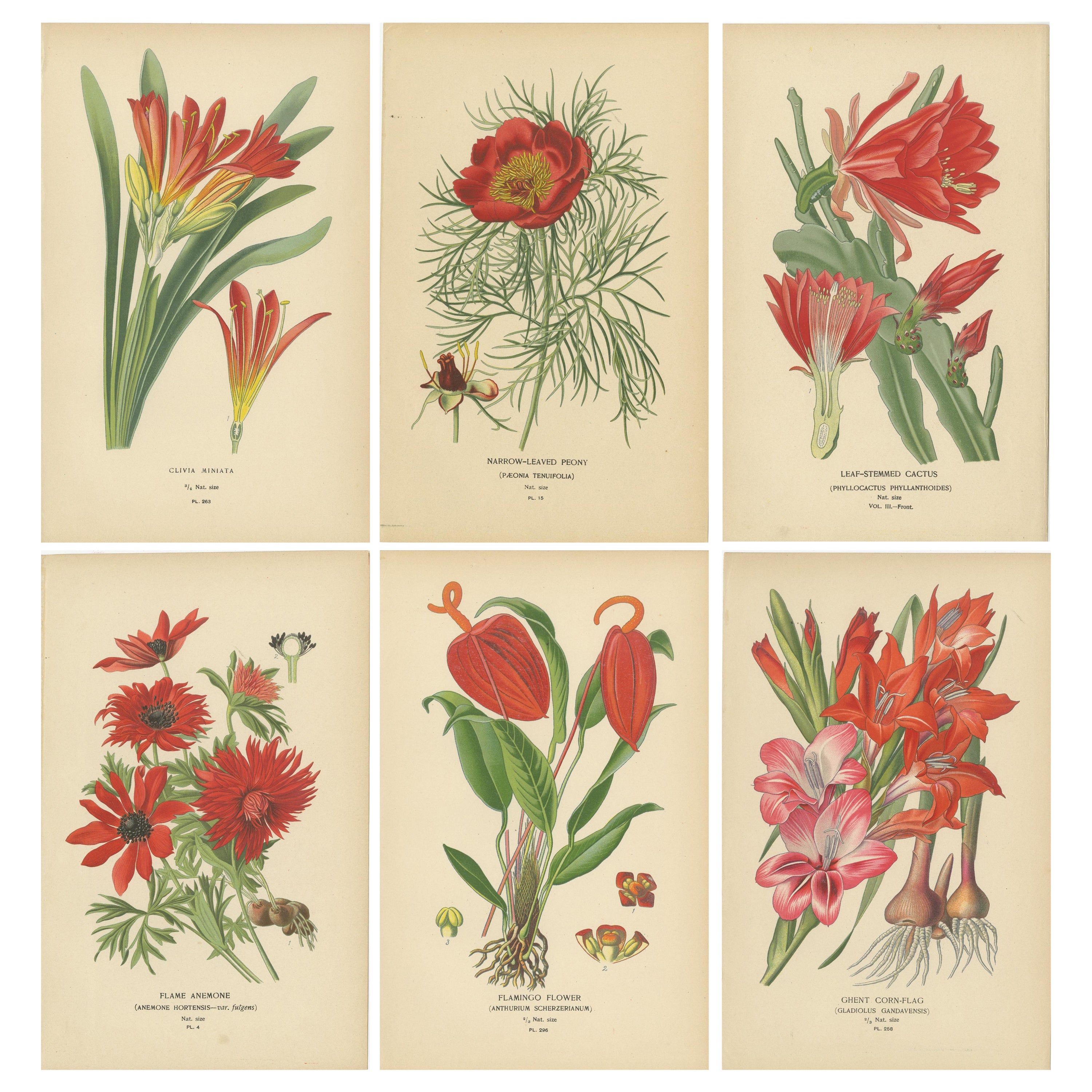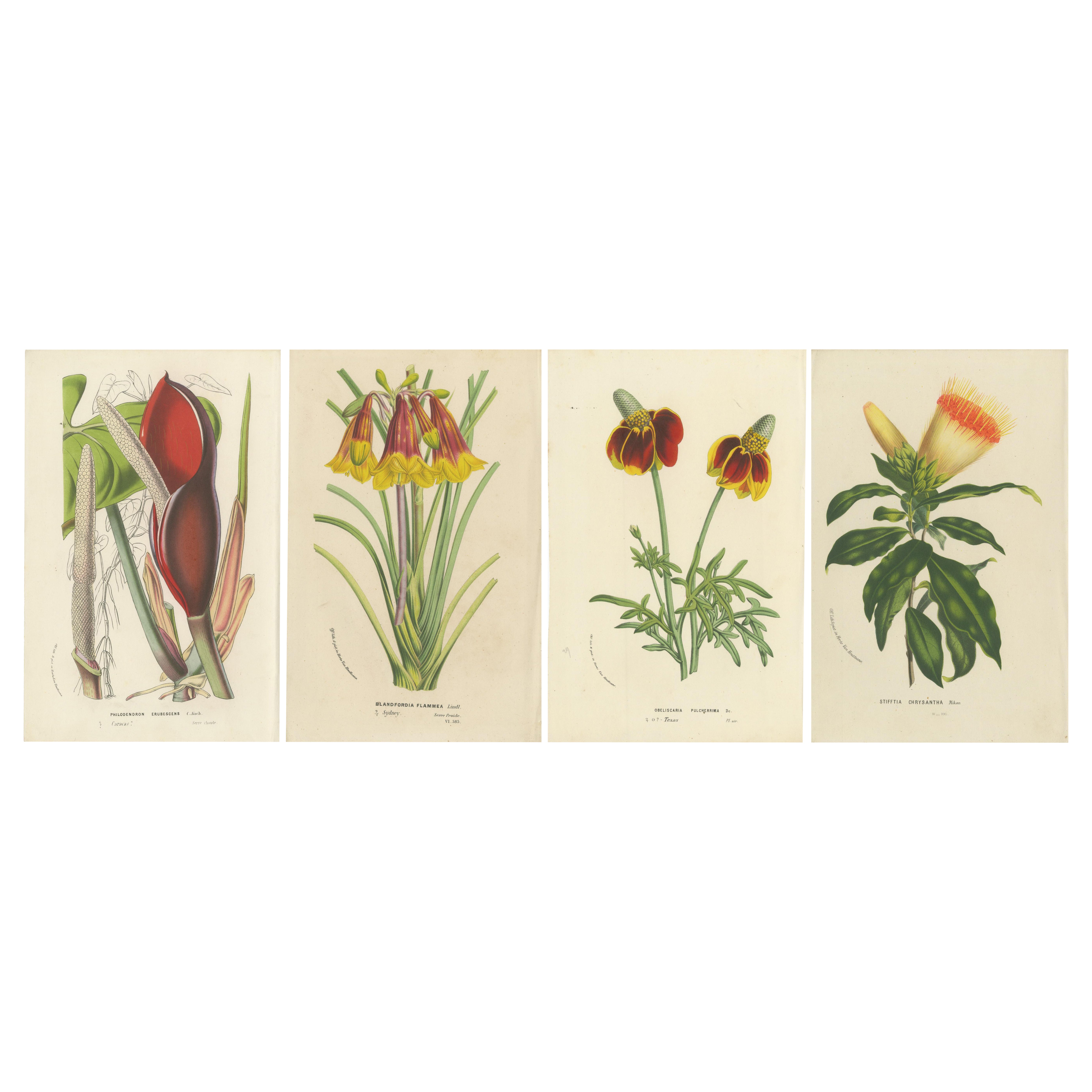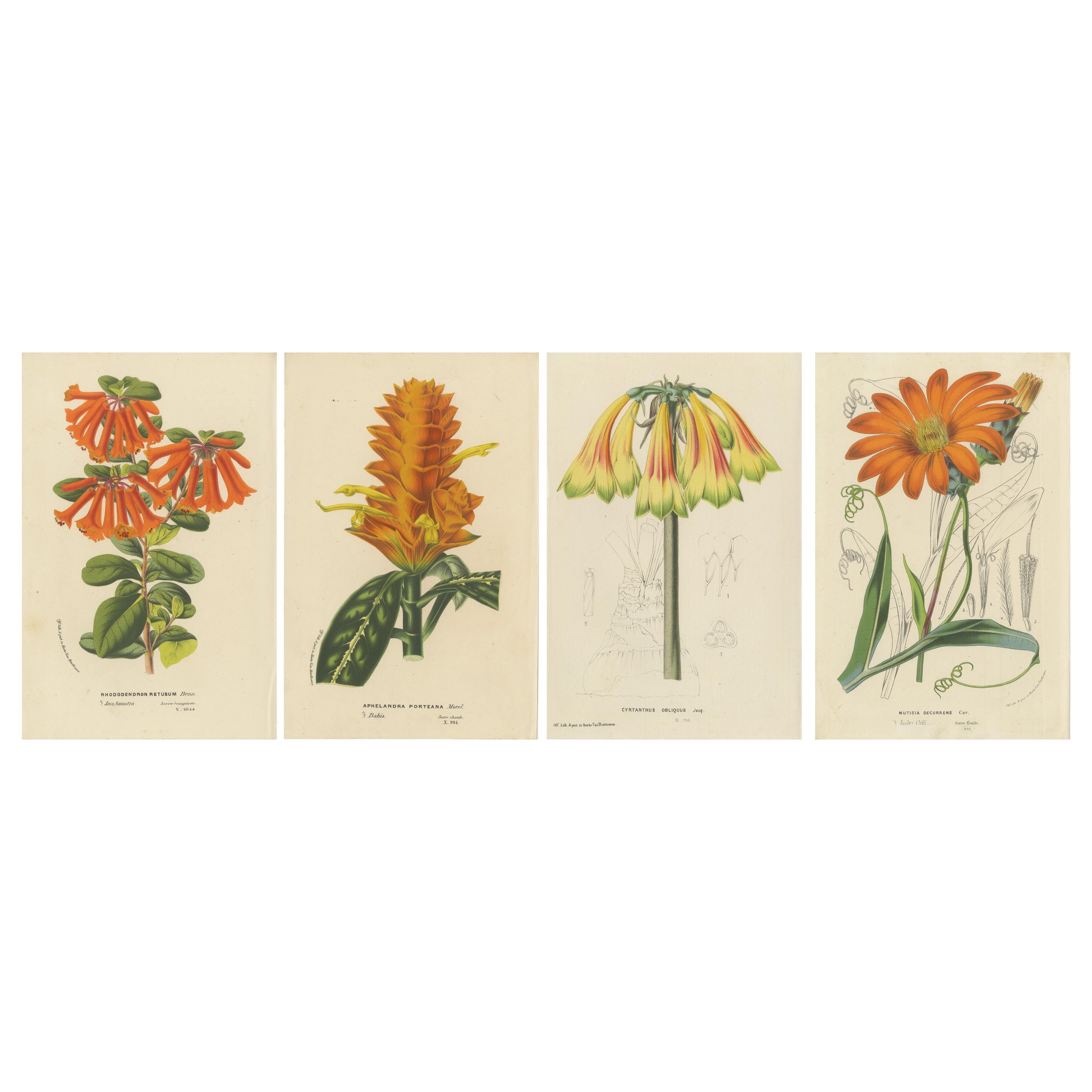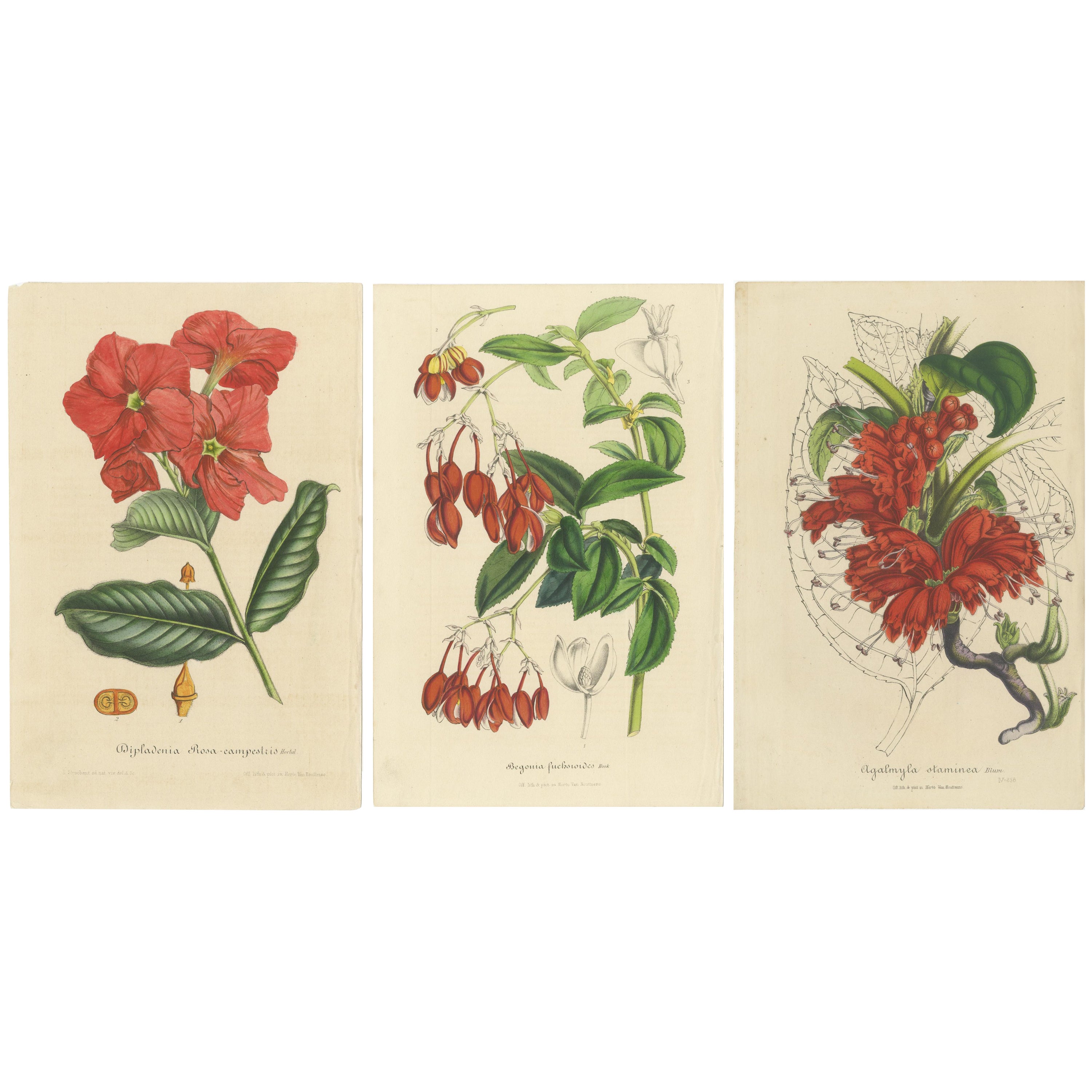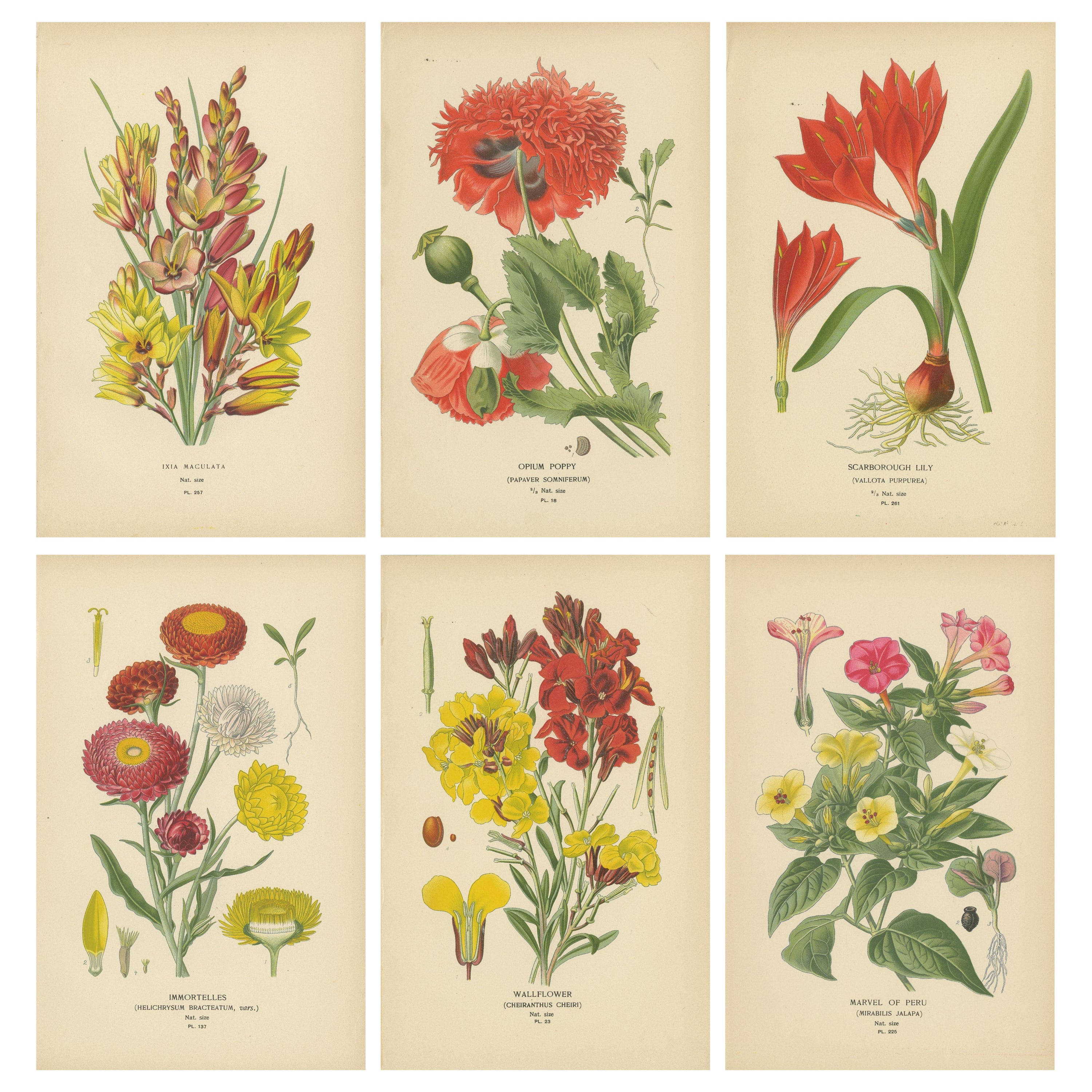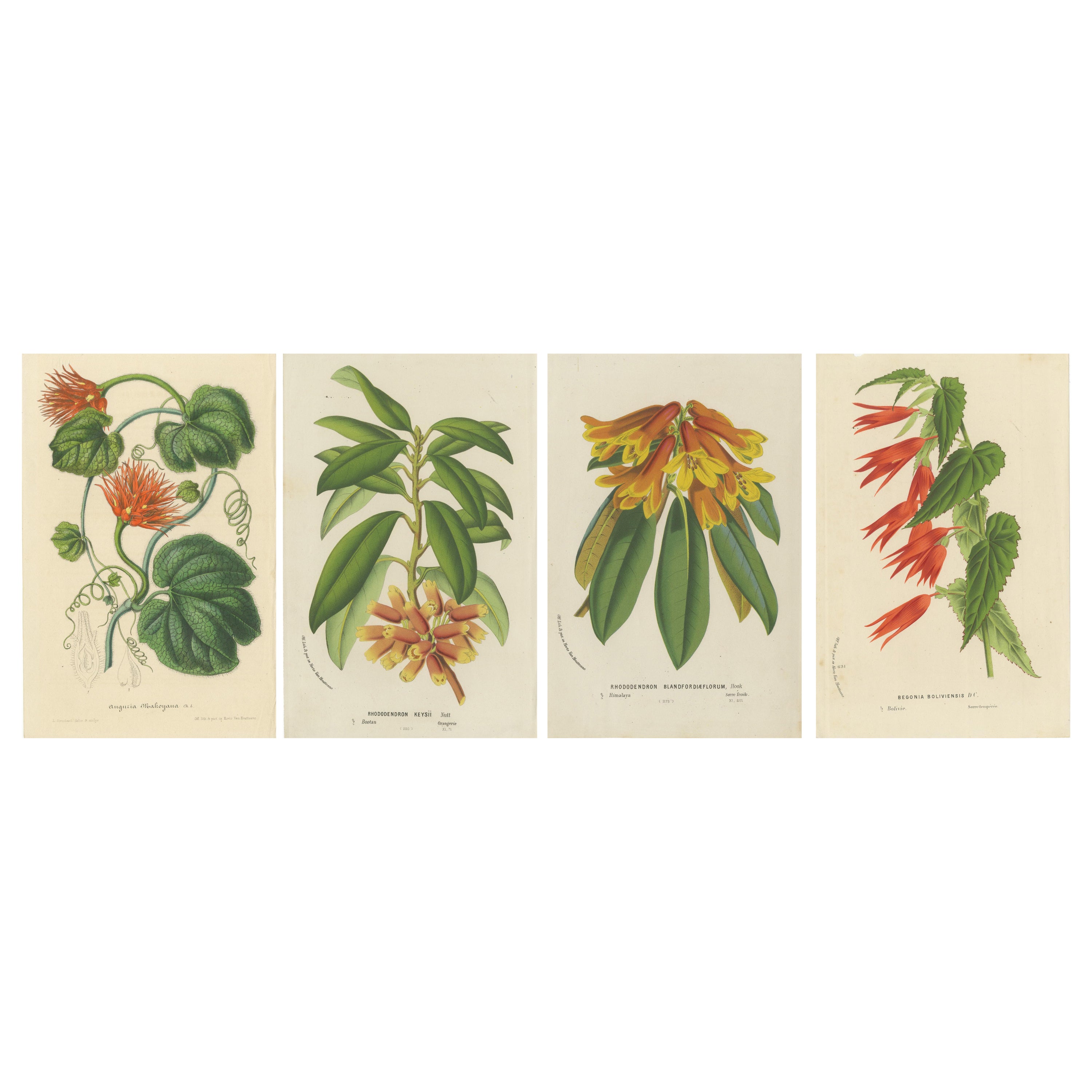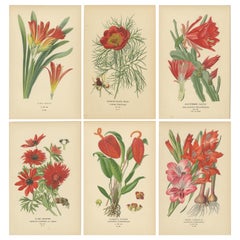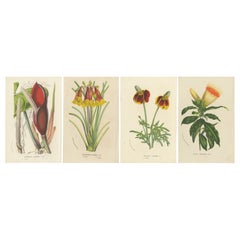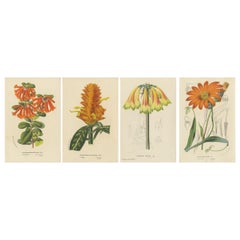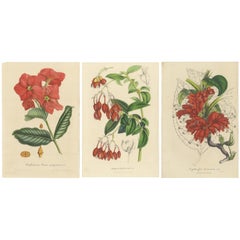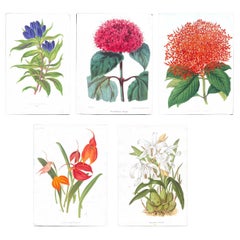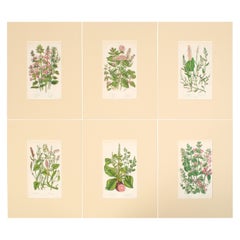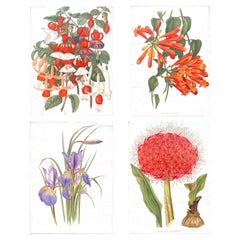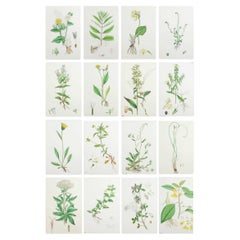Articles similaires à Illustrations botaniques originales d'époque tirées de la Revue Horticole, circa 1855
Vous voulez plus d'images ou de vidéos ?
Demander au vendeur plus d'images ou de vidéos
1 sur 10
Illustrations botaniques originales d'époque tirées de la Revue Horticole, circa 1855
536 €par ensemble|TVA incluse
670 €par ensemble20 % de remise
À propos de cet article
Here are descriptions of the eight botanical illustrations, including the Latin and English names of the plants, why they are significant, and details about the creators and the technique used to produce these antique prints.
1. Stanhopea x bellaerensis
- Latin Name: *Stanhopea x bellaerensis*
- Common Name: Stanhopea Orchid Hybrid
- Special Features: This orchid species is known for its striking yellow petals, which are speckled with red-brown spots. Orchids in the *Stanhopea* genus are highly prized by collectors for their complex flower structures and enchanting fragrance. What makes *Stanhopea* orchids particularly interesting is their habit of blooming downward, requiring the flowers to grow through slats or hanging pots, as depicted in the print.
- Artist: L. Descamps-Sabouret
- Technique: Chromolithography, printed by G. Severyns in Brussels.
2. Physalis Franchetii
- Latin Name: *Physalis Franchetii*
- Common Name: Chinese Lantern Plant
- Special Features: The *Physalis* is known for its bright orange, lantern-like husk that surrounds the fruit, making it a popular ornamental plant. The lantern-like structure is actually the enlarged calyx of the flower. The plant is interesting for both its ornamental appeal and its edible fruits, which are enclosed in these colorful, papery husks.
- Artist: L. Descamps-Sabouret
- Technique: Chromolithography by J.L. Goffart in Brussels.
3. Mutisia viciaefolia
- Latin Name: *Mutisia viciaefolia*
- Common Name: Mutisia
- Special Features: This climbing vine is native to the Andean regions of South America. It features bright, red-orange flowers with striking contrast against its fern-like leaves. What makes *Mutisia* interesting is its adaptation to high-altitude environments, where its flowers attract hummingbirds for pollination. Its vibrant color and exotic origin make it a special plant in both horticulture and botanical studies.
- Artist: Godart
- Technique: Chromolithography by G. Severyns.
4. Erigeron aurantiacus
- Latin Name: *Erigeron aurantiacus*
- Common Name: Orange Fleabane
- Special Features: This species is characterized by its vivid orange, daisy-like flowers. It is a perennial plant that is native to Central Asia and is often used in alpine gardens due to its hardiness and striking floral display. The bright orange color is uncommon in the *Erigeron* genus, making this species highly sought after by gardeners.
- Artist: Godart
- Technique: Chromolithography by G. Severyns.
5. Caraguata conifera
- Latin Name: *Caraguata conifera* (now more commonly referred to as *Aechmea conifera*)
- Common Name: Conifer Bromeliad
- Special Features: This plant, a member of the Bromeliad family, is known for its vibrant conical inflorescence with bright red and yellow bracts. Native to tropical regions, it thrives in humid conditions and is an epiphyte, meaning it grows on other plants. Its ornamental and exotic appearance makes it highly valued among collectors.
- Artist: L. Descamps-Sabouret
- Technique: Chromolithography by G. Severyns.
6. Odontoglossum Rossii majus and Sophronitis grandiflora aurantiaca
- Latin Names: *Odontoglossum Rossii majus* and *Sophronitis grandiflora aurantiaca*
- Common Names: Ross's Odontoglossum and Sophronitis Orchid
- Special Features: These two orchids are shown together. *Odontoglossum Rossii* is known for its mottled sepals and petals with intricate color patterns, while *Sophronitis grandiflora* is admired for its fiery red flowers. Both species are rare and highly collectible due to their stunning blooms and difficulty in cultivation. Orchids are particularly fascinating for their intricate reproductive structures, which have evolved to attract specific pollinators.
- Artist: Godart
- Technique: Chromolithography by G. Severyns.
7. Tritoma nobilis
- Latin Name: *Tritoma nobilis* (now commonly referred to as *Kniphofia nobilis*)
- Common Name: Red Hot Poker
- Special Features: This striking plant, native to South Africa, is known for its tall flower spikes that transition in color from bright red at the top to yellow at the base, resembling a torch. The vibrant colors attract hummingbirds and other pollinators. The plant is particularly interesting for its heat tolerance and dramatic appearance in gardens.
- Artist: Godart
- Technique: Chromolithography by G. Severyns.
8. Neumannia arcuata
- Latin Name: *Neumannia arcuata*
- Common Name: Neumann's Orchid
- Special Features: This epiphytic orchid is known for its slender red bracts and green foliage. It is native to tropical rainforests, where it clings to trees and other surfaces. Orchids like *Neumannia arcuata* are fascinating due to their ability to grow in the canopy of the rainforest, surviving on minimal soil and absorbing nutrients from the air and rain.
- Artist: Coriat
- Technique: Chromolithography by G. Severyns.
Why These Plants Are Special:
- Aesthetic Appeal: The vivid colors, unusual shapes, and textures of these plants make them highly desirable in both horticulture and botanical illustration.
- Ecological Importance: Many of these species are native to tropical and subtropical regions, playing important roles in their ecosystems by providing food and shelter for various pollinators, including hummingbirds, bees, and butterflies.
- Horticultural Value* Many of these plants have been introduced into cultivation due to their ornamental appeal. Their exotic origins and unusual forms make them favorites in gardens and greenhouses around the world.
Artists and Maker:
- L. Descamps-Sabouret, Godart, and Coriat: These botanical artists were notable contributors to the world of scientific illustration in the 19th century. Their work was crucial in helping botanists and horticulturists study, identify, and classify new plant species.
- Chromolithography by G. Severyns, J.L. Goffart: These prints were created using chromolithography, a labor-intensive color printing technique that allowed for rich, multi-colored images to be produced. The process was particularly well-suited to botanical illustrations, as it enabled artists to capture the vivid colors and intricate details of plants. Severyns and Goffart were among the best chromolithographers in Belgium, known for their high-quality prints.
Technique - Chromolithography:
- Chromolithography was a revolutionary color printing technique developed in the 19th century. It involved using multiple stones or plates, one for each color, to build up an image layer by layer. This method allowed artists to create prints with a high degree of color accuracy and detail, making it ideal for botanical illustrations. The process required great skill and precision, as each color had to be aligned perfectly to produce a cohesive and vibrant final image. Chromolithographs were widely used in scientific publications, like *Revue Horticole*, to depict new plant species in an accurate and attractive manner.
- Dimensions:Hauteur : 25 cm (9,85 po)Largeur : 16 cm (6,3 po)Profondeur : 0,02 mm (0 po)
- Vendu en tant que:Lot de 8
- Matériaux et techniques:
- Période:
- Date de fabrication:circa 1855
- État:Condition: Very good, given age. General age-related toning and/or occasional minor defects from handling. Please study scan carefully.
- Adresse du vendeur:Langweer, NL
- Numéro de référence:Vendeur : BG-13761,-84 BG-13761-86, etc1stDibs : LU3054341456762
À propos du vendeur
5,0
Vendeur reconnu
Ces vendeurs prestigieux sont des leaders du secteur. Ils représentent le summum en matière de qualité et de design.
Vendeur Platine
Vendeurs premium dont la note est supérieure à 4,7 et le délai de réponse de 24 heures maximum
Établi en 2009
Vendeur 1stDibs depuis 2017
2 531 ventes sur 1stDibs
Temps de réponse habituel : <1 heure
- ExpéditionRecherche du devis...Expédition depuis : Langweer, Pays-Bas
- Politique des retours
Certaines parties de cette page ont été traduites automatiquement. 1stDibs ne garantit pas l'exactitude des traductions. L'anglais est la langue par défaut de ce site web.
Garantie d'authenticité
Bien qu'il soit peu probable que la situation se présente, dans le cas où vous rencontreriez un problème d'authenticité d'un article, contactez-nous dans un délai d'un an pour obtenir un remboursement intégral. DétailsGarantie de remboursement
Si votre article n'est pas conforme à la description, est endommagé pendant le transport ou ne vous est pas livré, contactez-nous sous 7 jours pour obtenir un remboursement intégral. DétailsAnnulation sous 24 heures
Vous disposez d'un délai de 24 heures pour annuler votre achat sans motif.Des vendeurs professionnels agréés
Nos vendeurs de renommée mondiale doivent respecter des normes strictes en matière de service et de qualité, afin de préserver l'intégrité de nos fiches produit.Garantie d'alignement des prix
Si vous constatez qu'un autre vendeur a mis en vente le même article à un prix inférieur sur un autre site, nous nous alignerons sur ce prix.Livraison en toute confiance à l'international
Notre réseau de transporteurs de premier ordre propose des options d'expédition spécialisées dans le monde entier, y compris des livraisons personnalisées.Plus d'articles de ce vendeur
Tout afficherIllustrations botaniques de l'époque victorienne : Une Celebrity visuelle de la flore
Il s'agit de vibrantes chromolithographies extraites de "Favourite Flowers of Garden and Greenhouse" d'Edward Step, illustrées par Désiré Boi et publiées en 1896 par Frederick Warne ...
Catégorie
Antiquités, années 1870, Estampes
Matériaux
Papier
392 € Prix de vente / ensemble
20 % de remise
Flora Illustrated: A Collection of 19th Century Botanical Art, publié vers 1875
Les estampes représentent diverses espèces botaniques, chacune illustrée avec une attention particulière à la morphologie des plantes, y compris les feuilles, les fleurs et parfois l...
Catégorie
Antiquités, années 1870, Estampes
Matériaux
Papier
272 € Prix de vente / ensemble
20 % de remise
Portraits botaniques vibrants : exquises illustrations de plantes du 19e siècle
Ces illustrations, exécutées avec précision et richement colorées, sont de beaux exemples de chromolithographie, une technique populaire au 19e siècle pour sa capacité à produire des...
Catégorie
Antiquités, années 1870, Estampes
Matériaux
Papier
304 € Prix de vente / ensemble
20 % de remise
Illustrations botaniques exquises tirées du Curtis's Botanical Magazine (1847)
Ces magnifiques illustrations botaniques colorées à la main, dessinées et lithographiées par le célèbre artiste Walter Hood Fitch, ont été publiées dans le *"Curtis's Botanical Magaz...
Catégorie
Antiquités, années 1840, Estampes
Matériaux
Papier
344 € Prix de vente / ensemble
20 % de remise
Trésors floraux : Chromolithographies du XIXe siècle de la collection botanique
Les six chromolithographies suivantes font partie d'une collection publiée en 1896, créée par Désiré Bois et Edward Step. Ils illustrent des sujets botaniques avec une attention rema...
Catégorie
Antiquités, années 1890, Estampes
Matériaux
Papier
432 € Prix de vente / ensemble
20 % de remise
Luxuriant et vibrant : The Collective of Exotic Botanical Illustrations, circa 1875
Les gravures représentent une sélection de plantes exotiques avec un niveau de détail remarquable et des couleurs vibrantes, mettant en valeur la beauté et la diversité de la vie bot...
Catégorie
Antiquités, années 1870, Estampes
Matériaux
Papier
328 € Prix de vente / ensemble
20 % de remise
Suggestions
Bignonia venusta - Chromolithographie botanique ancienne, années 1880
Une étonnante estampe botanique originale des années 1880, représentant Bignonia venusta, également connue sous le nom de vigne à flamme ou de vigne à trompette orange. Cette illustr...
Catégorie
Antiquités, XIXe siècle, Français, Estampes
Matériaux
Papier
Ensemble de six gravures botaniques anglaises du 19ème siècle, Angleterre, vers 1880
Un ensemble de six gravures botaniques anglaises du 19ème siècle, Angleterre C.1880.
Monté, prêt à être encadré.
Beaux exemples, en excellent état proportionnel à l'âge.
Catégorie
Antiquités, Fin du XIXe siècle, Anglais, Victorien, Estampes
Matériaux
Papier
Gravure botanique originale des années 1880 de l'Hæmanthus Kalbreyeri - Chromol antique vibrant
Cette impressionnante chromolithographie originale des années 1880 représente le spectaculaire Hæmanthus kalbreyeri, également connu sous le nom de lis sanguin. Caractérisée par une ...
Catégorie
Antiquités, XIXe siècle, Français, Estampes
Matériaux
Papier
Ensemble de 16 estampes botaniques originales d'antiquités, vers 1850
Merveilleux ensemble de 16 estampes botaniques
Lithographies d'après les dessins botaniques originaux de Hooker.
Couleur originale
Publié, vers 1850
Sans cadre.
La mesure donnée...
Catégorie
Antiquités, années 1850, Anglais, Début de l'époque victorienne, Estampes
Matériaux
Papier
396 € / ensemble
Livraison gratuite
Ensemble de 6 estampes botaniques originales et anciennes, vers 1870
Joli ensemble de 6 imprimés botaniques
Chromo-lithographies
Couleur originale
Publié, vers 1870
Non encadré.
La mesure donnée est pour une impression.
Expédition gratuite
Catégorie
Antiquités, années 1870, Anglais, Victorien, Estampes
Matériaux
Papier
123 € / ensemble
Livraison gratuite
Début du XXe siècle, estampes botaniques italiennes
Début du 20e siècle, tirages botaniques italiens. 8 disponibles.
Catégorie
